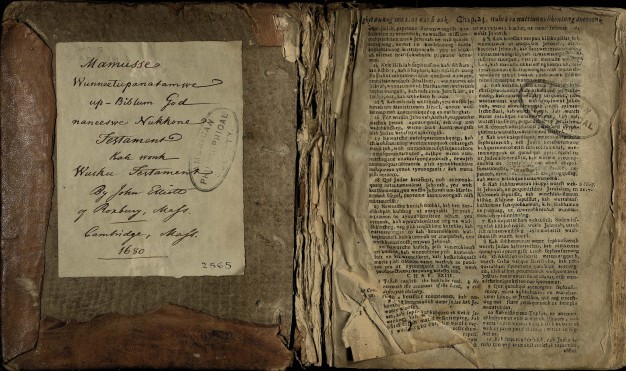Up Biblum, the 2nd Edition
It is hard to imagine that Benjamin Franklin did not hear stories about “the war” growing up. Not the American Revolution of course, but the war his mother Abiah and grandfather Peter Folger lived through a century before that began in 1675: King Philip’s War. Though not as widely known as the American Revolution, this conflict was equally earth-shattering and marks one of the darkest moments in New England’s history. The loss in English communities was astounding—some 1,000 English men, women, and children dead, 25 English towns severely damaged and 16 entirely destroyed, and thousands of cows, sheeps, and pigs gone. Grimmer still were the losses in Native communities which reduced the entire region’s Indian population by half. Those events and losses haunt some Native communities to this day. This conflict was a defining moment in Peter Folger’s life and it also has something to tell us about the item I mentioned in my last blog, the APS’s copy of Up-Biblum.
When last we left Peter Folger, he was busy with Thomas Mayhew, Jr., and Christian Wampanoag leaders such as Hiacoomes, John Tackanash, Momonaquem, and John Nanoso, building alphabetic literacy efforts in Wampanoag communities on Noepe (later Martha’s Vineyard). Tragedy struck in 1657, however, when a ship bound for England disappeared at sea, claiming the life of Thomas Mayhew, Jr. Mayhew’s father, Thomas Sr., grieved his son’s death for years and eventually joined the missionary work but soon made it clear that there was no place for Folger and his Anabaptist religious views. Folger felt the same and left the island in 1662. Like other men searching for religious tolerance, he moved first to Rhode Island but then relocated again to Nantucket. This last move stuck and this is where Folger raised his family, included Abiah, Benjamin Franklin’s mother.
As on Martha’s Vineyard, Folger’s Wôpanâak language skills proved useful in the local relationships between English and Indian leaders. When King Philip’s War broke out on the mainland, both Nantucket and Martha’s Vineyard avoided bloodshed, to no small degree because of the working relationship that men like Folger and Wampanoag leaders maintained. Though strained and imperfect, these relationships kept the peace. When local Englishmen began to disregard Folger’s work, he was quick to remind that he had “bin Interpreter here from the Beginning of the Plantation when no Englishman but myself could speak scare a Word of Indian, at which Time I am sure some of these men that deal thus with me now, had felt Arrows in their sides…had I not stept in between them and made Peace.” Though tense, Nantucket heard about rather than saw the horrors of the war.
The war prompted a slew of English publications reflecting on the events of the past years including the best-selling captivity narrative of Mary Rowlandson. Peter Folger too composed a small work set to verse, A Looking Glass for the Times, though it did not generate much attention. His grandson Benjamin Franklin, however, remembered it fondly and described it as “written with a manly freedom, and a pleasing slimplicity.” And yet, just as the war spurred a proliferation of printed English pages, the war consumed volumes worth of Wôpanâak ones, including vast numbers of Up-Biblum, the Wôpanâak language Bible. While there were doubtlessly still copies in the hands of Wampanoag and Nipmuc families after the fighting, even missionary John Eliot was at pains to produce one. When two book buyers approached him for a copy after the war, Eliot could only sadly inform them that “all the Bibles and Testaments were carried away, and burnt or destroyed, so that he had not been able to save any for himself.” Though Eliot could not bring himself to write about the war, he did commit to publishing a second edition. This second edition, born from the horrors of King Philip’s War, is the edition that many libraries, including the APS, now owns.

